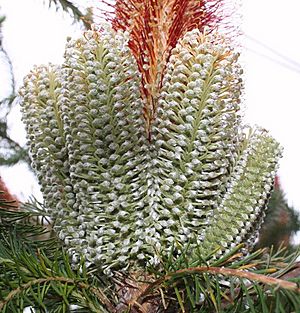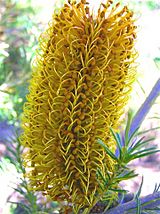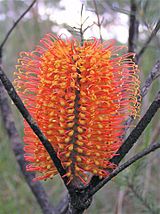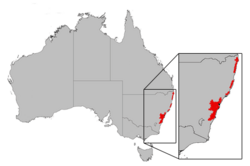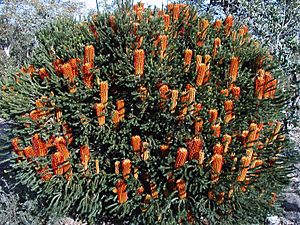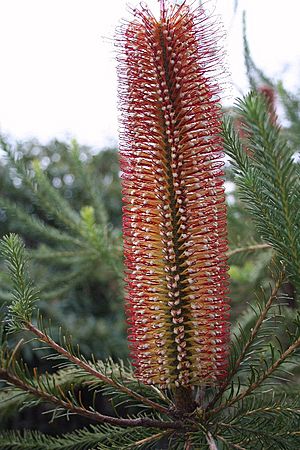Heath-leaved banksia facts for kids
Quick facts for kids Heath-leaved banksia |
|
|---|---|
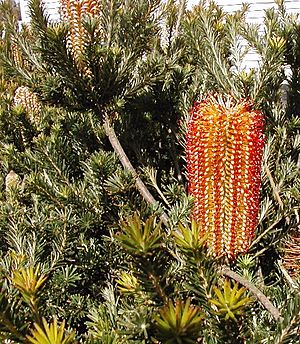 |
|
| Banksia ericifolia growing in a garden | |
| Scientific classification | |
| Genus: |
Banksia
|
| Species: |
ericifolia
|
| Subspecies | |
|
|
| Synonyms | |
|
|
The Banksia ericifolia, also known as the lantern banksia or heath-leaved banksia, is a type of woody shrub that belongs to the Proteaceae family. It is native to Australia. This plant grows in two separate areas of central and northern New South Wales, east of the Great Dividing Range.
It is famous for its bright orange or red flowers that appear in autumn. These flowers stand out against its green, fine, heath-like leaves. The lantern banksia is usually a medium to large shrub. It can grow up to 6 metres (20 feet) tall and wide. However, in windy coastal areas or open heathlands, it is often smaller, about 1 to 2 metres (3 to 7 feet) tall.
Banksia ericifolia was one of the first Banksia species collected by Joseph Banks in 1770 near Botany Bay. It was later named by Carl Linnaeus the Younger in 1782. This unique plant has two main types, called subspecies. One is Banksia ericifolia subspecies ericifolia, found around Sydney. The other is Banksia ericifolia subspecies macrantha, found on the far north coast of New South Wales. This second type was officially recognized in 1996.
For many years, Banksia ericifolia has been a popular plant in Australian gardens, especially on the east coast. Its flowers are also sometimes used in the cut flower industry. Recently, smaller types of this plant, like Banksia 'Little Eric', have become popular for smaller gardens.
Contents
What it Looks Like
The Banksia ericifolia grows as a large shrub. It can reach up to 6 metres (20 feet) tall. But in windy places like coastal or mountain heathlands, it is often smaller, around 1 to 2 metres (3 to 7 feet). Its bark is grey, smooth, and quite thin. It has small spots called lenticels. As the plant gets older, the bark can become much thicker.
The leaves are dark green, small, and narrow. They are usually 9 to 20 millimetres (0.35 to 0.79 inches) long and about 1 millimetre (0.04 inches) wide. They often have two tiny teeth at their tips. The leaves grow very close together and are arranged alternately on the branches. New leaves usually grow in summer and are a pretty lime green color.
The flowers bloom in autumn, or in winter in cooler areas. They grow in tall flower spikes. These spikes are 7 to 22 centimetres (3 to 9 inches) high and about 5 centimetres (2 inches) wide. Each flower has a tube-shaped perianth made of four joined parts called tepals. It also has a long, thin, wire-like part called a style.
A special feature of this plant is that its styles are hooked, not straight. The ends of the styles are first held inside the flower parts. But when the flowers open, they break free. The flower spikes are usually red or gold. Their styles can be golden, orange, orange-red, or burgundy. Sometimes, you can find unusual forms with bright red styles on whitish flowers. Very rarely, some plants have all-yellow flowers. The flower spikes are easy to see, sticking out from the leaves. They grow from branches that are two to three years old.
Old flower spikes turn brown, then grey. The old flower parts soon fall off. This reveals many small, dark grey to dull black seed pods, called follicles. These pods are oblong and 15 to 20 millimetres (0.59 to 0.79 inches) across. Each pod has ridges and stays closed until a fire burns it.
Life Cycle and Fire
Banksia ericifolia is killed by fire. But it grows back from its seeds. The plant needs several years to grow and flower in the wild. This means it is very sensitive to fires that happen too often. It has disappeared from some areas where fires occur too frequently. However, as plants get older and produce more seed pods, they can store many seeds. An eight-year-old plant can store up to 16,500 seeds! Some plants grow many flower spikes from one spot.
How it Got its Name
Banksia ericifolia was first collected on April 29, 1770, at Botany Bay. It was found by Sir Joseph Banks and Dr Daniel Solander. They were naturalists on Captain James Cook's ship, the Endeavour. However, the plant was not officially named until April 1782. That's when Carolus Linnaeus the Younger described the first four Banksia species.
Linnaeus named the species based on their leaf shapes. So, the plant with leaves that looked like heather was named ericaefolia. This name comes from the Latin words erica (meaning "heather") and folium (meaning "leaf"). The spelling was later changed to "ericifolia". So, the full scientific name is Banksia ericifolia L.f. The "L.f." tells us that Carolus Linnaeus the Younger named it.
Even though many Banksia species have had their names changed over time, B. ericifolia has mostly kept its original name. Sometimes, plants can have different scientific names over time, but the name Banksia ericifolia has remained the main one.
A more recent change happened in 1981. Scientists recognized that there were different forms of B. ericifolia. In 1996, one of these forms was officially named a subspecies: B. ericifolia subsp. macrantha.
Subspecies
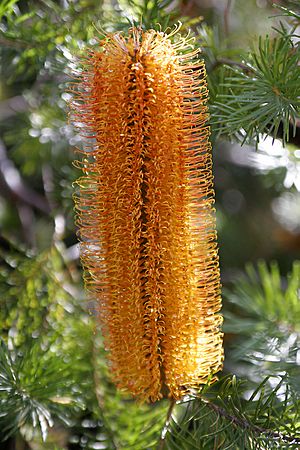
There are two main types of Banksia ericifolia, found in different areas:
- Banksia ericifolia subsp. ericifolia
- This type is found around Sydney, stretching south to the Illawarra and north to Collaroy. It also grows in the Blue Mountains. The leaves of young plants have 2 to 6 teeth on each side. The flower parts (perianths) are 19 to 22 millimetres (0.75 to 0.87 inches) long. The styles are 30 to 35 millimetres (1.2 to 1.4 inches) long.
- Banksia ericifolia subsp. macrantha
- This northern type is found on the New South Wales north coast. It grows from Crowdy Head north to the Queensland border. This subspecies has finer leaves that are more crowded. Its flowers are larger, with perianths 26 to 28 millimetres (1.0 to 1.1 inches) long and styles 46 to 48 millimetres (1.8 to 1.9 inches) long. Young plants usually have one or two teeth on each side of their leaves. Some plants in Crowdy Bay National Park have very tall flower spikes, up to 26 centimetres (10 inches) high.
Name and Symbolism
In 1992, B. ericifolia became the official plant of Sydney. You can often see it planted in parks and public areas around the city. The local Eora and Darug people of the Sydney area called it wadanggari.
Where it Lives
In nature, the ericifolia type grows in acidic, sandy soils. You can find it in high heathlands within 2 kilometres (1.2 miles) of the coast around the Sydney area. This stretches from Collaroy south to Jervis Bay. It also grows in sandy mountain areas like the Blue Mountains and the Budawangs. These heathlands are often moist, with water underground, and can even be quite swampy.
It can grow in dense groups with other plants like the Dagger Hakea (Hakea teretifolia) and Scrub She-oak (Allocasuarina distyla). Other plants that grow near it include the Coast Tea-tree (Leptospermum laevigatum). Its bright flowers are a beautiful sight during autumn bushwalking in sandstone areas. You can see them in places like the Kings Tableland walk in the Blue Mountains and Royal National Park.
The northern subspecies macrantha is found in two separate areas on the far north coast of New South Wales. The first area is from Crowdy Bay north to Hat Head National Park. The second area is from Yuraygir National Park north to Kingscliff. This type mostly grows near the coast, usually within two kilometres of the ocean, or in swampy areas. It might grow alongside Banksia oblongifolia.
Ecology and Pollination
Like other banksias, B. ericifolia is very important for many animals. It provides a lot of nectar in autumn, when other flowers are hard to find. Many studies have looked at how it is pollinated.
A study in 1998 found that small mammals visit B. ericifolia flowers in northern New South Wales. These include marsupials like the Antechinus flavipes and rodents like the Rattus tunneyi. These animals carry a lot of pollen, making them good pollinators. Another study in 1978 found that Rattus fuscipes also carried a lot of pollen. The hooked styles of the flowers might help with pollination by mammals. Other visitors include the Apis mellifera.
Many types of birds also visit this Banksia. A 1985 study in Sydney found many honeyeater birds visiting the flowers. These included the eastern spinebill, white-cheeked honeyeater, New Holland honeyeater, and red wattlebird. The Silvereye also visits. Birds and insects are important for the plant to make seeds.
Insects can also be found on the flowers. The banksia boring moth (Arotrophora canthelias) eats parts of the flowers when it is young. As it gets older, it tunnels into the flower spike and eats the seeds. This tunneling can stop seeds from growing. Other insects that eat seeds include certain moths and a type of weevil.
Like most other Proteaceae plants, B. ericifolia has special roots called proteoid roots. These roots have dense groups of short side roots that form a mat just under the leaf litter. They help the plant get nutrients from poor soils, especially soils that don't have much phosphorus. This plant does not have a lignotuber. This means it is killed by fire and grows back only from its seeds.
Banksia ericifolia needs fire to grow new plants. If fires don't happen often enough, the old plants will die out. But if fires happen too often, it's also a problem. This plant takes about six years to grow big enough to flower. One study suggested that fires should happen every 15 to 30 years for the plant to thrive. Many Banksia ericifolia plants grow near towns and cities in Australia. Bushland near cities can have too many fires, either from arson or planned burns. This has caused the plant to disappear from some areas. The hotter a fire is, the faster the seeds are released. The timing of rain after a fire is also very important for young plants to survive.
Growing it in Gardens
Banksia ericifolia was one of the first Banksia species to be grown in gardens. It was brought to England in 1788. By 1804, it was flowering in several collections. That year, a painting of the plant was shown in Curtis's Botanical Magazine. The text said it was a "handsome shrub [that] thrives freely."
The flowers of Banksia ericifolia attract many birds to gardens. This plant is tough enough to be used as a street plant in some parts of Sydney. It is quite easy to grow if it has the right conditions. It likes sandy, well-drained soil and a sunny spot. It needs extra water during dry times until it is settled, which can take up to two years. This is because it comes from an area that gets most of its rain in warmer months. It is also resistant to a plant disease called Phytophthora cinnamomi dieback, like most eastern banksias.
Since it naturally grows in acidic soils, Banksia ericifolia can be sensitive to not enough iron. This problem is called chlorosis. It makes new leaves turn yellow while the veins stay green. This can happen if the plant is grown in soil with a high pH, especially if there is cement in the soil. You can treat this with iron supplements.
It can take a few years for the plant to flower from seed, usually at least four years. Buying a larger plant or one grown from a cutting can make it flower faster. Banksia ericifolia can be easily grown from seed. It is also one of the easier banksias to grow from cuttings. Special types of plants, called cultivars, must be grown from cuttings. This makes sure the new plant is exactly like the original.
Regular pruning is important to keep the plant looking good and stop it from becoming too leggy (tall and thin with few leaves). It's not a good idea to prune this banksia very hard below the green growth. This is because it doesn't have a lignotuber. A lignotuber is a woody swelling at the base of some plants that helps them sprout new growth after fire or heavy pruning. So, Banksia ericifolia cannot easily sprout from old wood like some other banksias.
Special Garden Types (Cultivars)
For many years, garden growers focused on special types of Banksia spinulosa. But since the late 1990s, more and more special types (cultivars) of Banksia ericifolia have become available. These include different flower colors and dwarf (small) forms. The dwarf forms are very popular because the original plant can grow up to 6 metres (20 feet) tall. These new, smaller types help people choose a plant that fits their garden size. Banksia ericifolia is also grown for cut flowers in Australia.
Here are some of the special types you might find:
- Banksia ericifolia 'Bronzed Aussie' is a type that grows to 2 metres (7 feet) tall. It has bronze-colored leaves and honey-colored flower parts.
- Banksia ericifolia 'Golden Girl' has golden yellow flowers and blue-grey leaves. It grows to about 1.5 to 1.8 metres (5 to 6 feet) tall.
- Banksia ericifolia 'Kanangra Gold' has gold flowers and grows to 4 metres (13 feet) tall. It is a bushy plant with paler flowers than the usual orange or red types.
- Banksia ericifolia 'Limelight'' is a large plant, up to 5 metres (16 feet) tall. It has bright lime green leaves and orange flowers. It's not seen as often now because people prefer smaller plants for their gardens.
- Banksia ericifolia 'Little Eric' is a dwarf type that grows to 1 or 2 metres (3 or 7 feet) tall. Its flowers have maroon styles and whitish perianths.
- Banksia ericifolia 'Purple Pygmy', also called B. 'Port Wine', is a dwarf type that grows to 1 metre (3 feet) tall. It has purplish leaves and claret-colored flowers. It doesn't flower very often.
- Banksia ericifolia 'Red Rover' is a dwarf type that reaches 1.8 metres (6 feet) tall. It has lime green leaves and bright red flowers.
- Banksia ericifolia 'St Pauls' is a dwarf type that grows to 2 metres (7 feet) tall. It has striking red flowers.
- Banksia ericifolia 'White Candles/Christmas Candles', also known as B. ericifolia 'Ruby Clusters', has an unusual mix of red styles and white flower bodies. It is an open shrub that grows to 3 to 4 metres (10 to 13 feet) tall.
- Banksia ericifolia macrantha 'Creamed Honey', named for its cream-colored flowers. This type was found at Crowdy Head. It grows to 4 or 5 metres (13 or 16 feet) tall and has a more open shape. It is the only special type of the northern Banksia ericifolia subspecies that is currently available.


